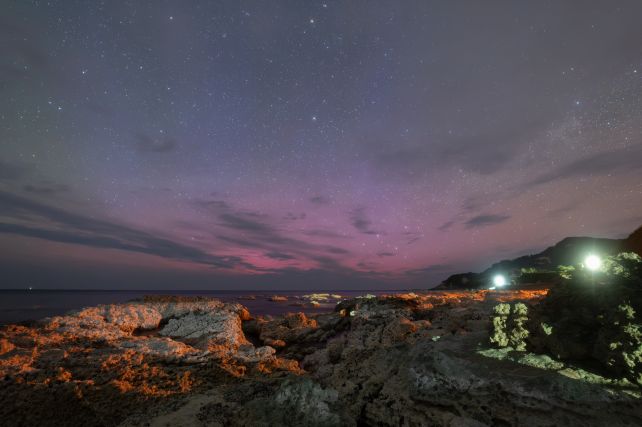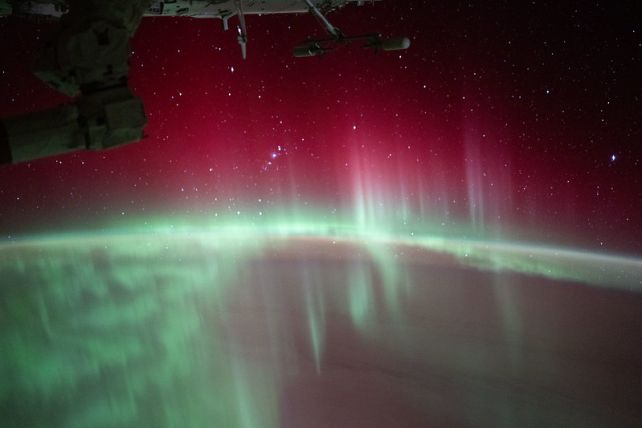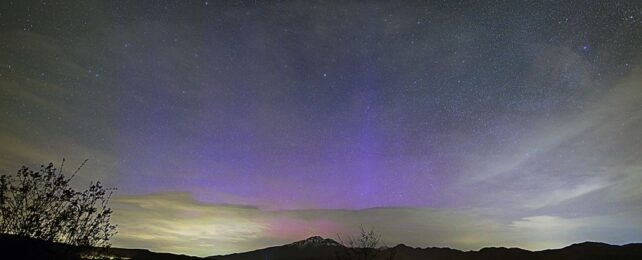Conjure, in your mind's eye, a visual to accompany the word 'aurora'. What you imagine might be dominated by the color green, elaborate swirls and swooshes that dance across the sky above a frozen landscape.
But the opulent glows that appear in the sky – as atmospheric gasses are struck by energetic solar particles – aren't limited to the most well-known manifestation. Auroras can appear in a wide array of hues that vary according to altitude, latitude, and which gasses are involved.
For the particularly powerful geomagnetic storm that rattled Earth's magnetic cage in May 2024, a strange blue glow appeared. That is not unheard-of… but this one was at low latitudes, reaching unusually high into the sky.
Now, using images snapped by citizen scientists in Japan, physicists Sota Nanjo of the Swedish Institute of Space Physics and Kazuo Shiokawa of Nagoya University have figured out the most likely explanation for the eerie blue light.
But their explanation creates another problem that atmospheric scientists will need to solve.

"Our findings suggest that nitrogen molecular ions may have accelerated upward by some mechanism and were responsible for the formation of the blue-dominant aurora," Shiokawa explains.
"To date, it is not well understood how nitrogen molecular ions with large molecular weight can exist at such high altitudes. Such ions are not easily able to exist for long periods of time due to their heavy mass and short dissociative-recombination time intervals; however, they are observed at high altitudes. The process is shrouded in mystery."
Earth's auroras are usually the result of a huge influx of solar particles, unleashed from the Sun in a coronal mass ejection or solar wind. These particles stream through the Solar System.
If Earth is in the path of the eruption, the particles slam into the magnetic field, where they are diverted and accelerated along magnetic field lines to the poles, where they are dumped into the atmosphere.
The interaction between the solar particles and the gasses in Earth's atmosphere causes the atmospheric particles to gain a bit of energy. When the atoms making up the atmospheric gasses drop back to their original energy state, the energy is released as a photon – that's the source of the glow.
It's similar to the mechanism that makes fluorescent lights glow. And, as with fluorescent lights, the color of the glow depends on different factors, such as the type of particle, and the amount of energy they gain and lose.
Green and red auroras, for example, are generated by oxygen atoms losing energy at different altitudes. Nitrogen atoms can emit blue and red photons. When these hues mix in the sky, they can produce yellow, purple, pink, and orange colors.
Usually, low-latitude aurora is red. But, on 11 May 2024, a pink glow lit up the sky at low latitudes, and a distinctly blue glow appeared shortly before midnight. And we have a powerful new tool for capturing auroral phenomena: the smartphones of fascinated aurora-watchers around the world.
With the wealth of images and video collected on the blue aurora, the researchers were able to measure the phenomenon in detail.
They found that the aurora was arranged in longitudinal structures that ran along magnetic field lines, for around 1,200 kilometers (about 750 miles). It was also arranged into three separate structures, and reached high into the sky, between altitudes of 400 and 900 kilometers.
For context, the International Space Station orbits at a height of between 370 and 460 kilometers.
Currently, low-latitude auroras are thought to be related to the ring current. This is a torus-shaped current of charged particles trapped inside Earth's magnetosphere, circling the planet's equator like a pool flotation ring.
A geomagnetic storm energizes the energetic neutral atoms (ENAs) in the ring, causing the low-latitude auroral glow.

But the researchers don't believe that the ring current works for what they observed.
"In this study, a structure of several hundred kilometers was found in the blue-dominant aurora in the longitudinal direction, which is difficult to interpret by ENA activity only," Shiokawa says. "In addition, ENAs are unlikely to create auroral structures aligned with magnetic field lines, as observed in this study."
It's possible the ring current played a role, but the researchers believe something else had to have been at play to produce the distinct, field-aligned structures observed. They believe that molecular nitrogen ions were somehow accelerated upwards. But what accelerated them is unknown.
This suggests that there may be some as-yet unidentified process in Earth's atmosphere.
We may not have enough information at the current time to figure out what that process is. But answers are tantalizingly within grasp.
"As solar activity increases in the coming years," the researchers write, "repeated case analyses of such blue-dominant auroras are expected to provide insights into the generation processes of blue-dominant low-latitude auroras."
The research has been published in Earth, Planets and Space.
